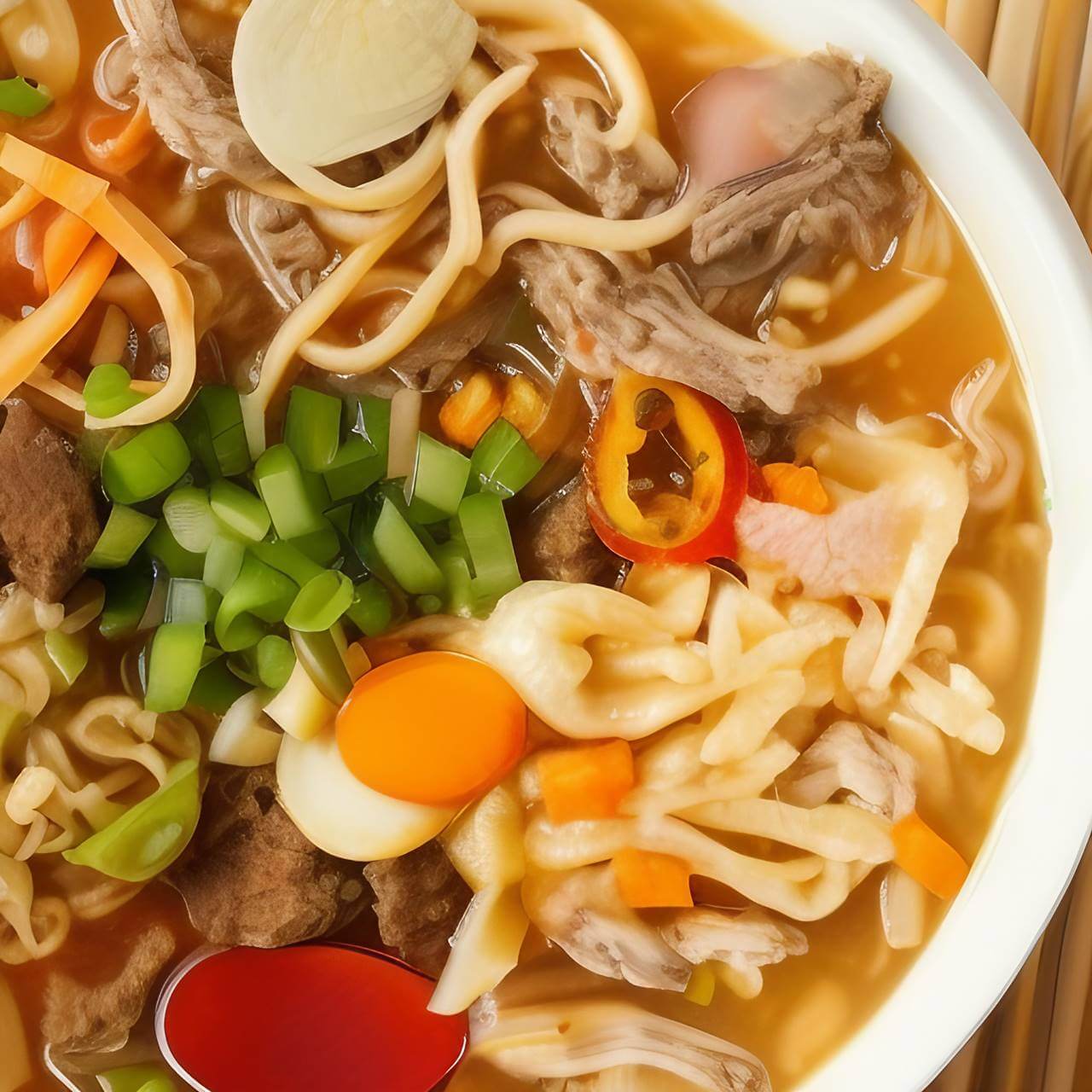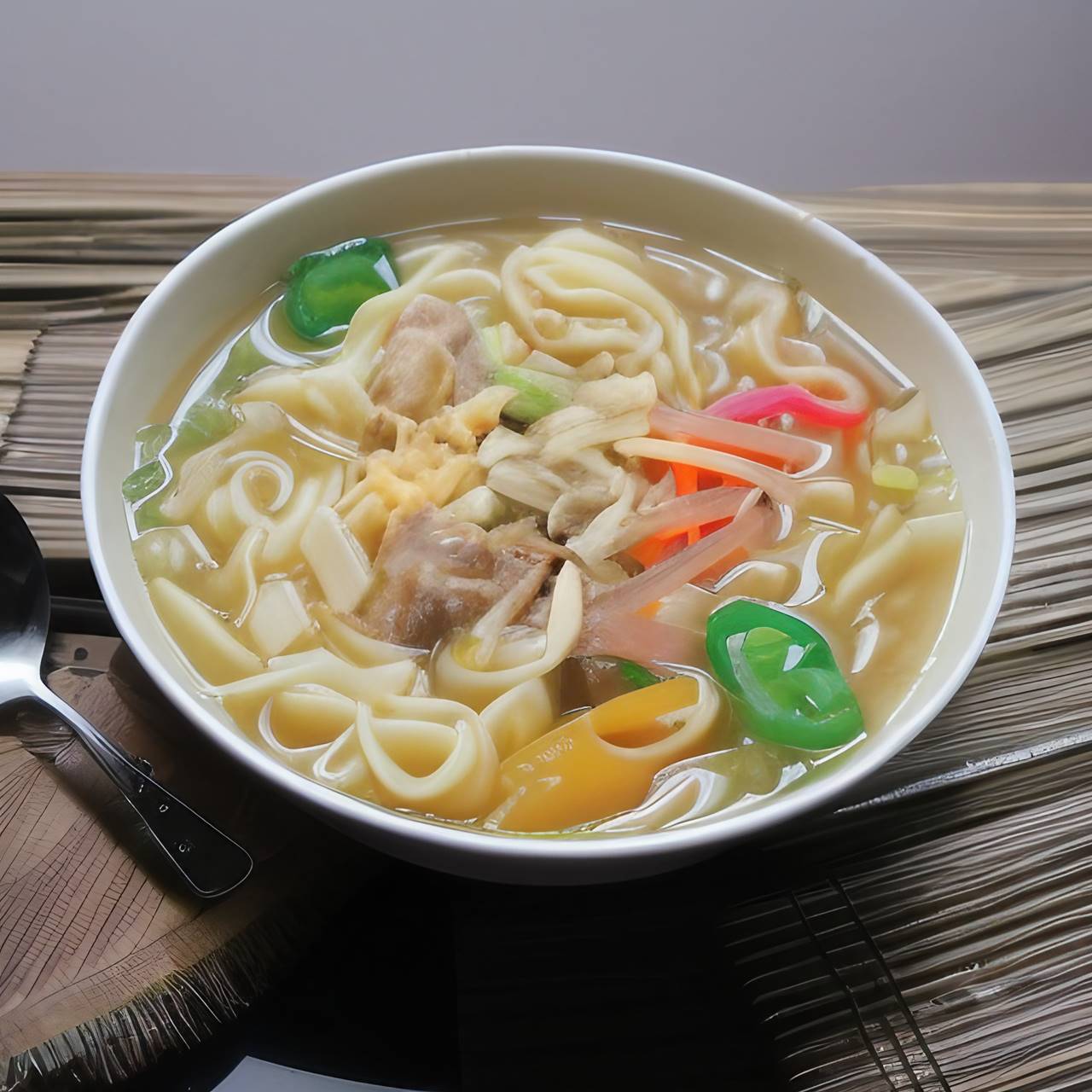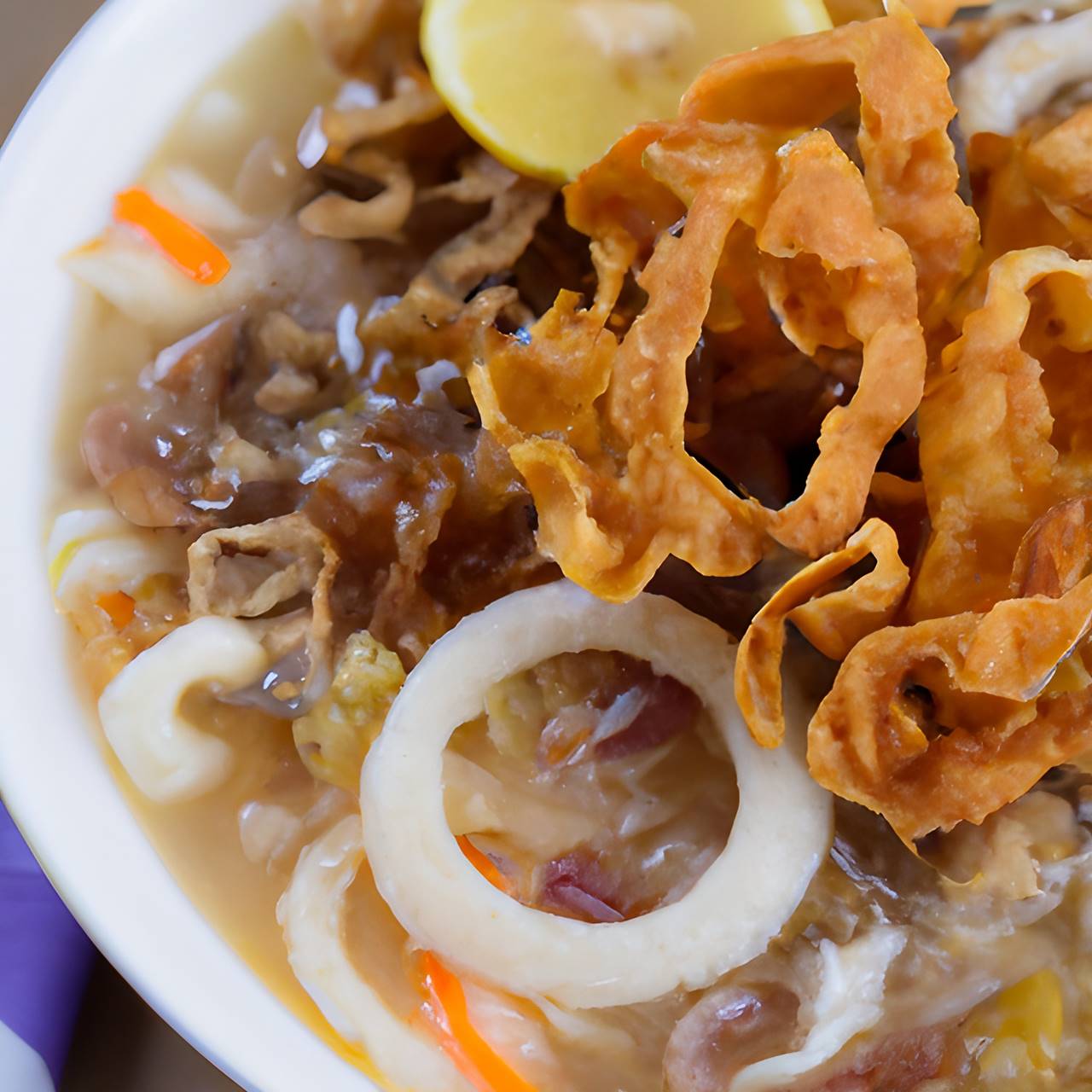This egg noodle dish is served with a creamy broth that holds a subtle, yet welcoming flavour. You are able to customize the taste of the noodles however you want by using condiments such as soy sauce, calamansi, and chili flakes for an extra kick! Abundantly topped with pork liver, kikiam and quail eggs, the beloved lomi is so ingrained in the local tradition that a dedicated festival used to be held annually every June devoted solely to it. The traditional Lomi Festival, which was last celebrated back in 2012, is still a source of pride and joy to those from Batangas even today.
Also Read: How to Cook Filipino Chicken Sotanghon Soup
So If you’re looking for something unique and different than your regular chicken soup, then Lomi is definitely the right choice! This Filipino noodle soups’ broth has a much thicker consistency compared to traditional versions. Raw egg is added which gives it an almost identical taste and texture as that of egg drop soup – but even more luxurious! Lastly, a mixture of water and cornstarch are included at the end of cooking making its texture deliciously creamy.
In order to make a proper Lomi, you’ll need some fresh ingredients. You’ll need the egg noodles which can be bought at any major supermarket – just make sure to get enough for 4-6 servings. Then you’ll need pork liver, kikiam and quail eggs as well as soy sauce, calamansi and chili flakes for some extra kick.
To cook the noodles, you’ll need to bring a pot of water to a boil before adding in your ingredients. Once everything is boiling together, reduce the heat and let it simmer for about 10 minutes or until the pork liver is cooked through. Lastly, add in the cornstarch mixture and stir it all together until the noodles are creamy and delicious.
Once everything is cooked, you can now ladle your Lomi into serving bowls and top it off with your desired condiments – calamansi, soy sauce and chili flakes all work great here! And there you have it – a steaming hot bowl of special homemade Lomi ready to be enjoyed. Enjoy with family and friends or just by yourself.

Ingredients
- Indulge in the creamy and succulent taste of 1/2 lb. of fresh flat miki noodles!
- Slice 10 ounces of boneless chicken breast into thin pieces.
- 1 Knorr Chicken Cube
- Chop up half of a medium-sized cabbage.
- 1 cup of freshly chopped carrots
- 1/2 cup of freshly chopped scallions.
- 1 large red onion cubed
- 5 cloves of garlic and gently crush them.
- 1 heaping tablespoon of cornstarch
- 2 eggs
- 7-8 cups of water
- One quarter teaspoon of freshly ground black pepper.
- Three hearty tablespoons of cooking oil
Steps to Make Special Lomi
- Heat the oil in a pot over medium heat until it glistens.
- Gently sauté garlic, onion, and carrots until they are fragrant and lightly browned.
- Brighten your chicken by sautéing it until its surface has a light golden hue.
- Carefully pour the water into the pot and bring it to a boil.
- Start by adding a Knorr chicken cube to the pot. Give it a stir, then cover with the lid and place on low-medium heat for 15 minutes until cooked through.
- Start by adding cabbage and miki noodles together. Then, let it cook for 8 to 10 minutes until done.
- Gently fold in the scallions and stir until fully incorporated.
- Thoroughly pour the egg into the mixture, stirring constantly to avoid it from clotting.
- Combine 1/4 cup of water with the cornstarch and stir until completely mixed. Then, pour this mixture into your pot and stir continually until your soup reaches its fully thickened consistency.
- Generously season the dish with salt and freshly-ground black pepper, then let it simmer for two minutes.
- Transfer the food to a serving bowl, and you’re ready for immediate indulgence!
- Share and enjoy!

Tips
- In choosing miki noodles , make sure you get the freshest and highest quality that you can find.
- In mixing the cornstarch make sure to incorporate it well to avoid clumps. If you want the soup to be spicier, add a few teaspoons of chili powder during cooking or sprinkle some fresh chilies on top while serving. For added flavor and texture, feel free to add in pork liver, kikiam and quail eggs when sautéing.
- Lomi is a classic Filipino dish that’s been around for centuries and it continues to be a source of pride and joy to those from Batangas even
- You can switch out the chicken for pork or processed meat substitutes if you wish!
- Be generous with your seasonings, as this will give your Lomi a delicious depth of flavor.
- Feel free to experiment with other vegetables, such as bell peppers as well.
- I like the vegetables to be crisp when biting into the Lomi, so I prefer to add them in near the end of cooking time. So choose the freshest vegetables you can find! Lomi is best enjoyed as soon as it is made, as the noodles tend to get mushy when left for prolonged periods. So make sure you serve it hot and fresh out of the pot!
- Make sure not to overcook your eggs as they will become rubbery and tough.
- If you find the soup too thick, you can always thin it with more water until it reaches your desired consistency.
With this delicious recipe, you now have the power to create unique and flavorful dishes that will tantalize your taste buds. The wonderful thing about Lomi is its versatility-you can customize it to your own preferences and add in a myriad of ingredients to give it your own special touch. You can combine ingredients and your protein to choose what you want in your Lomi.
I would always remember eating Lomi at my favorite Chinese restaurant especially during special occasions. This is why I wanted to learn how to make it for myself at home. After a few trial and errors, I finally figured out the perfect recipe for this classic dish. I hope this recipe will help you create a dish that’s as delicious and memorable as mine.
Frequently Asked Questions
1. What kind of noodles should I use for Lomi?
Most people prefer to use miki or fresh egg noodles for Lomi, as they are generally easier to work with and provide a firmer texture. However, you can also try other types of noodles such as bihon or sotanghon if you wish.
2. Can I use pork or other substitutes instead of chicken?
Absolutely! Lomi can be made with any type of protein that you prefer, such as pork, beef, tofu, fish or processed meat substitutes. This will help to provide a different flavor and texture for your dish.
3. How can I add more flavor to my Lomi?
Feel free to experiment with different seasonings, such as chili powder and fresh chilies. You can also add in other ingredients like pork liver, kikiam or quail eggs when sautéing for added texture and flavor. Have fun with it!
4. How can I thin the soup if it’s too thick?
If you find that your Lomi is too thick, simply add in more water until it reaches your desired consistency. Don’t forget to adjust the seasonings as well!
5. How do I know when my Lomi is done cooking?
You’ll know that your Lomi is done when the noodles are cooked through, and all of the vegetables have been softened. Taste-test to make sure that everything has cooked properly and adjust seasoning accordingly. Enjoy!
6. How do I store leftovers?
If you have any Lomi leftovers, you can store them in an airtight container in the refrigerator for up to three days. Reheat on the stovetop or in the microwave until it’s piping hot before serving.

Summary
Lomi is a classic Filipino dish that has been around for centuries and it continues to be enjoyed by many today. With this delicious recipe, you now have the power to create unique and flavorful dishes with your own special touch. Whether you use chicken, pork or processed meat substitutes, feel free to experiment with different seasonings and vegetables to give your Lomi its own distinct flavor profile.
Don’t forget not to overcook the eggs! If you find the soup too thick, simply thin it out with more water until it reaches your desired consistency. Finally make sure to store any leftovers in an airtight container in the refrigerator so they remain fresh and tasty when reheated before serving again. Happy eating!